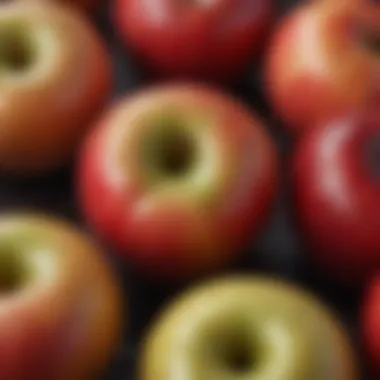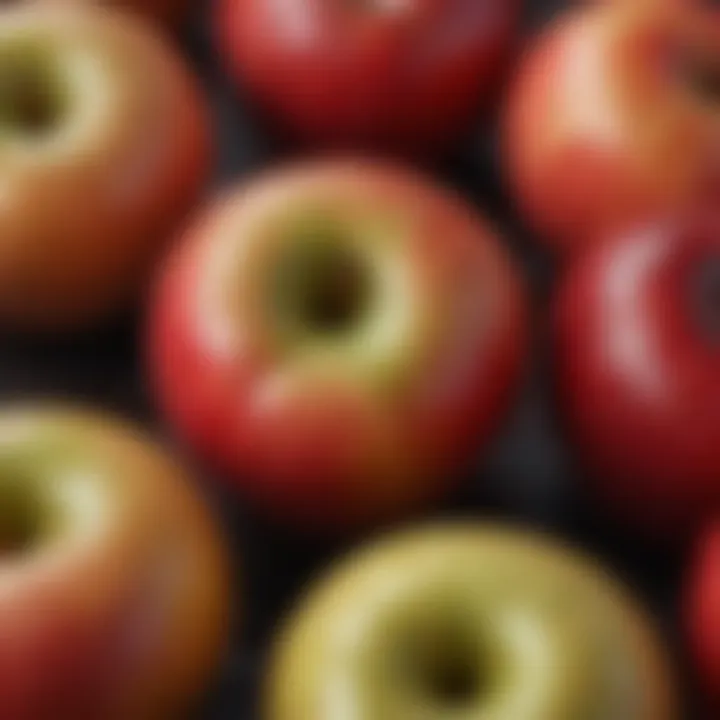Choosing the Best Apples for Baking: A Guide


Intro
Baking with apples brings warmth and comfort to any kitchen. However, selecting the right type of apple can make or break a dish. Apples vary greatly in flavor, texture, and how they hold up during the baking process. Understanding these nuances is essential for achieving the desired results in your recipes.
The complexity of this topic requires careful exploration of key apple varieties. This guide aims to illuminate the specifics, helping both novice and experienced bakers choose the ideal apples for their dishes. By delving into flavor, texture, and cooking characteristics, this article equips you with the knowledge to excel in your baking endeavors.
Key Points to be Discussed
- Flavor profiles of different apple varieties
- Texture considerations for baking applications
- The impact of apple choice on popular recipes like pies and crisps
- Tips on identifying and selecting the best apples in the store
Through this comprehensive guide, readers can expect to gain a robust understanding of how to select the perfect apple for their baking purposes, enhancing not only their skills but also their overall culinary satisfaction.
The Importance of Apple Selection in Baking
Choosing the right apple variety is essential for creating baked goods that delight the palate and satisfy texture preferences. The apple’s characteristics directly influence the final product, making selection a crucial step in the baking process. An apple that is ideal for one recipe may fall short in another. Understanding these differences helps in crafting desserts that are balanced in flavor and inviting in texture.
Why Choose the Right Apple Variety?
When baking, the apple variety used can make a significant difference. Some apples maintain their shape when baked, while others may mush together. For instance, Granny Smith apples bring tartness while holding their form, whereas Fuji apples may break down more in the oven. Choosing the right variety can ensure that your dish achieves not just the intended flavor but also the desired look and feel. This consideration is especially critical in classic recipes, like pies or crisps, where a harmonious combination of flavors and textures enhances the eating experience.
Impact on Flavor and Texture
The flavor profile of apples varies widely. Some are sweet, others tart, and each variety can contribute different notes to a recipe. For example, using a mix of sweet and tart apples can create a more complex taste in a dish. Beyond flavor, texture plays a pivotal role. A firm apple can provide a satisfying crunch, while a softer variety can lend a certain creaminess. These elements impact not only taste but also the overall experience of eating the dessert. A careful selection empowers bakers to elevate their dishes and surprise their guests.
"The right apple can transform an ordinary recipe into an extraordinary one."
In summary, the importance of choosing the correct apple for baking cannot be overstated. It influences both the flavor and texture of the final product, ensuring that each bite achieves a delightful balance. Such thoughtful selection leads to superior baking results.
Key Characteristics of Baking Apples
When it comes to baking with apples, understanding their key characteristics is vital. Selecting the proper apple enhances the overall quality of your dish, whether it is a pie, crisp, or a cake. Different varieties show distinct traits in taste, texture, and juiciness, all contributing to the final result. This section elaborates on elements that you should consider when choosing apples for baking.
Taste Profile: Sweetness vs. Tartness
The taste profile of an apple can significantly affect the flavor of the finished dish. Sweet apples deliver a more sugary flavor, while tart apples add a refreshing zing. For example, Granny Smith apples rank high on tartness, often balancing out a dessert's sweetness. This balance can be essential; a too-sweet filling may overwhelm the palate. Conversely, sweeter varieties like Fuji or Honeycrisp can help satisfy a sweet tooth without needing much added sugar.
In baking, blending sweet and tart apples can yield complex flavor profiles that engage the senses. Consider using a mix of both for pies, giving depth to the apple filling. Sweet apples suit desserts like crumbles, while tart apples excel in providing a counterbalance in tarts.
Texture: Firm vs. Soft
Texture plays a critical role in the appeal of baked apples. Firm apples maintain their structure when baked, creating a pleasant bite. Apples like Braeburn and Jonagold have a firm texture ideal for this purpose. On the other hand, soft apples can break down and become mushy during baking. While this may be desirable in certain recipes, it can ruin the integrity of others.
When selecting apples, think about the desired texture of your final dish. For an apple pie, you want that combination of a slightly chewy crust with firm bites of apple. In contrast, an apple sauce recipe can benefit from softer apples that break down easily.
Juiciness: The Role of Moisture
The juiciness of an apple affects not only the texture but also the moisture level in your baked goods. Juicy apples help to ensure that the filling does not dry out during baking. Varieties such as Honeycrisp are known for their juiciness, making them suitable for recipes that require moist fillings. In contrast, some apples might be drier, leading to a potential dry crust or filling.
When considering juiciness, it is essential to think about how the apple will interact with other ingredients in the recipe. A juicier apple may pair well with drier accompaniments like oats in a crumble, maintaining the overall texture and richness.
Key insight: When choosing apples, remember to also consider how their characteristics will influence the entire baking process.
Popular Apple Varieties for Baking
Selecting the right apple variety plays a critical role in the outcome of baked goods. Different apples have unique flavors, textures, and juiciness levels which can significantly change a recipe. Knowing which varieties excel in baking is essential for ensuring your dish turns out delicious and satisfying.
The best baking apples are generally those that maintain their structure when cooked, but also offer a balance of sweet and tart flavors. In this section, we will explore five popular varieties that are particularly well-suited for baking.


Granny Smith
Granny Smith apples are widely recognized for their sharp tartness. This variety stands out for its green skin and firm texture. They hold up excellently in various baking applications, especially in pies. The tart flavor they bring can balance the sweetness of the sugar and other ingredients. Because of their acidity, Granny Smith apples can enhance the overall taste profile of baked goods.
When using Granny Smith, think about cutting them into slices or cubes for your recipes. This apple variety is excellent for classic apple pies, where you want the filling to hold its shape and provide a crisp texture. They can be mixed with sweeter apples for a depth of flavor.
Honeycrisp
The Honeycrisp apple is known for its juicy sweetness and crisp flesh. This has gained popularity among bakers due to its delightful texture, which stays firm even when cooked. The complex flavor makes it a great choice for sweet dishes, whether in a pie or a crisp. This variety adds moisture to baked goods without becoming mushy, making it appealing.
In recipes, Honeycrisp apples shine when paired with cinnamon or caramel flavors. Their natural sweetness allows for reduced added sugar, allowing the apple's flavor to take center stage in your dishes.
Braeburn
Braeburn apples are an appealing middle ground between sweet and tart. Their notable crispness and excellent baking properties make them versatile. They hold their shape well, making them ideal for tarts and other baked desserts. The Braeburn's balanced flavor also complements spices perfectly, enriching the taste of whatever you bake.
This variety can be particularly effective in combinations. Mixing them with sweeter apples can create richer flavors in recipes. Consider using Braeburns when you want a deeper fruit profile in apple dumplings or baked desserts.
Fuji
Fuji apples are exceptionally sweet and very juicy as well. They are crunchy in texture, but their high sugar content can lead to a sweeter finished product. This is an important consideration when balancing the sugar in recipes. Fuji apples add notable moisture, benefiting cakes and muffins where a bit of softness is desirable.
For baked goods, use Fuji apples to create delicious batters or as filling in pastries. They can also serve well in cobblers, bringing a bright flavor that contrasts nicely with other ingredients.
Jonagold
Jonagold apples combine the best of both worlds—both sweetness and tanginess. This variety begins with a tart flavor and gradually evolves to sweetness, which can enrich the overall taste of your dish. With a firm texture, Jonagold apples hold up well during baking, making them suitable for pies and crisps.
When you think about flavor combinations, Jonagold apples work great with vanilla ice cream or whipped toppings. They can range from slightly sweet to more tart depending on ripeness, giving you flexibility in recipes.
Regional Varieties Worth Exploring
Understanding regional apple varieties can greatly enhance your baking repertoire. Apples that are locally grown often possess unique characteristics that can influence your recipes. Regional varieties may offer better flavor, freshness, and texture than standard options typically found in grocery stores.
When exploring different regions, you will find apples that are uniquely suited to specific climates and soils. These conditions influence taste, acidity, and sweetness, impacting your final baked product. Since regional apples are less commonly mass-produced, they can be more flavorful and aromatic, providing a distinctive twist to your dishes.
Additionally, using local varieties supports regional agriculture and minimizes environmental impact caused by transportation. Such choices not only benefit your kitchen but also your community’s economy. In this section, we will delve into three noteworthy regional varieties: Courtland, Prairie Spy, and Northern Spy.
Courtland
Courtland apples are renowned for their perfect balance of sweetness and tartness. This variety has a crisp texture, making it an excellent choice for pies and tarts. The skin is a beautiful blush of red, often speckled with green. Its flesh is creamy and white, which becomes tender and juicy when baked.
Some benefits when using Courtland in baking include:
- Flavor: It offers a mild sweetness that enhances desserts without overwhelming.
- Cooking Characteristics: Retains shape well under heat but softens enough to provide a luxurious mouthfeel.
- Versatility: Ideal for a range of dishes, including apple crisps and sauces.
Courtland apples are typically harvested in late summer to early fall, so their availability may vary by region.
Prairie Spy
Prairie Spy apples showcase a unique flavor profile, characterized by a sharper acidity that complements their sweet notes. These apples are quite firm, which makes them suitable for extended baking processes. With a striking appearance—often striped with red and yellow—Prairie Spy offers not just taste but also visual appeal in your dishes.
Here are some attributes to consider:
- Texture: Its dense flesh holds up well when baked, making it a frequent choice for apple pie.
- Storage: This variety keeps well, maintaining its quality over time, which is an asset for organized bakers.
- Flavor Development: The flavor becomes more complex with storage, deepening their taste after a few weeks.
The harvest occurs later in the fall, allowing you to create comforting apple dishes as the weather cools.


Northern Spy
Northern Spy apples are often praised among pastry chefs for their exceptional flavor and texture. This old variety offers a perfect blend of sweetness and tartness, making them an excellent candidate for baking. The skin has a soft red hue, and the flesh is crisp and juicy.
Key considerations include:
- Cooking Virtues: Northern Spy holds its structure well, providing a delightful experience in baked goods, from pies to turnovers.
- Seasonal Use: They are harvested late in the season, providing a fresh option for winter recipes.
- Complex Flavor: The complexity of taste makes them a remarkable choice for traditional recipes, imparting a rich flavor that makes them stand out.
These regional varieties each present unique qualities that contribute substantially to the baking process, making them worthy of exploration in various recipes.
Understanding the Baking Process
Baking is a transformational process that changes both the structure and flavor of ingredients. Understanding how apples react to heat is crucial for making informed choices when selecting apples for baking. The baking process not only influences the texture of the apples, but it also enhances or alters their natural flavors. This understanding is vital for creating a successful recipe where apples play a key role.
How Apples React to Heat
When exposed to heat, apples undergo significant changes. The heat softens their cellular structure, allowing them to lose moisture and release natural sugars. This can result in a balance of flavors, but it can also lead to issues if the apples are not suitable for baking. For example, softer apple varieties may turn to mush, losing their integrity in pies or crisps. In contrast, firmer varieties retain shape and provide a pleasant bite, enhancing the dish's overall texture.
Additionally, heat can cause a caramelization effect on the sugars of the apples. This enhances sweetness and adds complexity to the flavor profile. On the other hand, overheating can lead to a bitter taste and an undesirable texture. Therefore, selecting the right apple is key to achieving the perfect balance.
Baking Techniques for Different Varieties
Different apple varieties respond uniquely to various baking techniques. Here are some of the nuances that come into play:
- Slicing vs. Chunking: Firm apples like Granny Smith maintain their texture when sliced, while softer varieties may become mushy if cut too small.
- Pre-Cooking: For tougher varieties, like Northern Spy, slight pre-cooking may help soften them before incorporating into a dish, allowing for better integration with other ingredients.
- Baking Time: Adjust baking time based on the apple variety. Using a variety blend can yield desirable results, where some apples soften while others retain their shape.
"The right baking technique, paired with apples best suited for the process, can elevate any dessert."
By recognizing how heat alters apples and adapting baking methods accordingly, cooks can achieve remarkable results, whether making a simple apple pie or a more intricate tart.
Pairing Apples with Other Ingredients
When baking with apples, the selection of other ingredients can significantly elevate the flavor, texture, and overall enjoyment of the dish. Apples offer a natural sweetness and tartness, but it is through their pairing with spices and other flavors that their potential is fully realized. This section delves into the essential considerations for effectively combining apples with various ingredients to enhance baked goods.
Spices and Enhancements
Adding spices to an apple-based dish can transform it in remarkable ways. Some commonly used spices include cinnamon, nutmeg, and ginger. Each spice brings its unique characteristics, which complement the inherent qualities of apples. For instance, cinnamon not only adds warmth but also enhances the sweetness of tender varieties like Fuji or Honeycrisp. On the other hand, nutmeg provides a more complex flavor, which works well in richer recipes like apple pie.
In addition to spices, consider incorporating flavor enhancers such as citrus zest or vanilla extract. A splash of lemon juice can brighten the flavor of tart apples, while vanilla can add richness. The following are some effective combinations:
- Cinnamon and Sugar: Classic duo for baked apple desserts.
- Ginger and Clove: Great for spicing up apple crisps or turnovers.
- Lemon Zest and Honey: This combination can freshen tart apple slices before baking.
These combinations create a balanced flavor profile and make every bite more enjoyable.
Compounding Flavors in Recipes
The manner in which apples are combined with other ingredients in recipes plays a crucial role in achieving depth of flavor. For example, layering flavors can be effective in recipes such as apple crisp or apple cake. Start with a mixture of spices and sugars sprinkled over the apples before baking. This scope for complexity can elevate a simple dessert to something memorable.
Using nuts like pecans or walnuts can introduce crunch alongside the soft texture of apples. This not only varies the mouthfeel but also adds richness and a point of contrast in terms of flavor. It’s advisable to toast these nuts beforehand to amplify their flavor. Also, dried fruits, such as raisins or cranberries, work well in combination with baking apples, as they add both sweetness and chewiness.
Moreover, experiment with ratios based on the type of apple used. For instance, a sweet apple could benefit from a slight increase in acidity, perhaps via the introduction of apple cider vinegar. This encourages a balance that can counteract overwhelming sweetness and elevate the dish.
Ultimately, understanding how spices and other ingredients interact with apples can yield delightful bakes. Use these principles thoughtfully to create your own signature dishes.
"The key to successful baking is knowing how to blend flavors harmoniously, each ingredient adding a layer of taste that makes the dish complete."
Bringing all of these elements together, the pairing of apples with other ingredients is not merely a practice of combining; it is an art that can vastly improve the quality of your baked goods.


Storage and Preparation Tips
The way you store and prepare apples can significantly influence the quality of baked goods. Proper storage preserves freshness and flavor, while effective preparation ensures the apples can deliver the desired taste and texture in your recipes. This section explores strategies that every baker should consider when working with apples for baking.
Optimal Storage Conditions
To maintain the highest quality of apples, you should prioritize specific storage conditions. Apples benefit from cool, humid environments. When stored improperly, they can lose moisture and become mealy, which is not desirable when it comes to baking. Here are some guidelines for storing apples effectively:
- Temperature: Store apples in the refrigerator. The ideal temperature for apple preservation is between 30°F and 35°F.
- Humidity: Apples thrive in a humid atmosphere. Surrounding them with a damp paper towel can help maintain moisture.
- Packaging: It is best to keep apples in a perforated plastic bag, allowing for air circulation. Avoid sealing them tightly to reduce the likelihood of moisture build-up.
- Separation: Keep apples away from other fruits and vegetables, as they produce ethylene gas, which can hasten their spoilage.
Taking these steps can ensure that your apples remain firm and flavorful, ready to perform their best in any recipe.
Preparation Techniques for Baking
How you prepare apples influences both their flavor and texture in baked items. Proper preparation techniques can enhance the apples' characteristics, making them ideal for pies, crisps, or turnovers. Here are some vital preparation methods:
- Washing: Start by rinsing apples under cold water to remove any pesticide residues or dirt.
- Peeling: Depending on personal preference or recipe requirements, peeling apples can add a different texture. Some recipes work better with the skin on, while others benefit from a smoother consistency.
- Slicing: Cut your apples into uniform slices. Consistency in size ensures even cooking. The slice thickness may vary based on personal preference and the recipe.
- Tossing with Acid: To prevent browning and enhance flavor, toss slices in a bit of lemon juice immediately after cutting.
"A well-prepared apple can elevate any baked dish from ordinary to extraordinary."
Investing time in these storage and preparation practices will undoubtedly pay off when the final product emerges from the oven. Whether you aim for a rustic apple pie or an elegant tarte tatin, your attention to detail will yield the best results.
Common Baking Recipes Utilizing Apples
Baking with apples is both a tradition and an art. Apples add not only flavor, but also texture and moistness to various recipes. In this section, we will explore some common baking recipes that utilize apples, highlighting how different apple varieties can influence the final dish. These recipes provide a canvas to showcase the diverse flavors and textures of apples, making the selection of the right variety quite essential.
Apple Pie
Apple pie is perhaps the most iconic dessert featuring apples. The balance of sweet and tart flavors, combined with the flaky crust, creates a comforting experience. Using Granny Smith or Jonagold apples can enhance the tartness, contrasting nicely with the sweetness of added sugars. The firmness of these apples helps them retain shape during baking, preventing the filling from becoming too mushy.
For the crust, consider brands that offer pre-made options, or craft your own for a more personalized touch. The use of spices, such as cinnamon and nutmeg, complements the apples, enriching the overall flavor profile. A dash of lemon juice can also enhance bright notes while keeping the apples from browning too much.
"The perfect apple pie is a combination of well-selected apples and a skillfully crafted crust."
Apple Crisp
An apple crisp is a simpler yet equally delicious way to bake with apples. This dessert typically combines sliced apples with a crumbly topping made from oats, flour, sugar, and butter. It allows for a variety of apples to shine. Honeycrisp apples, known for their juicy texture and sweet flavor, work particularly well in this dish.
When preparing an apple crisp, it is beneficial to mix sweet apples with a tart variety, like Granny Smith. This combination creates depth and complexity in taste. The contrast between the warm, soft apples and the crunchy topping makes the dish appealing. Serve it warm with a scoop of vanilla ice cream to take the experience to a new level.
Apple Turnovers
Apple turnovers are handheld pastries that offer a delightful way to enjoy baked apples. Utilizing puff pastry or pie crust, you can wrap apples mixed with sugar, spices, and a hint of lemon. Fuji apples are a great option here, offering a sweet bite that can shine when baked. The puff pastry provides a light and flaky exterior, balancing the soft, sweet apple filling.
The preparation of apple turnovers can be simplified by using frozen pastry dough. Ensure the filling is not overly moist; this may cause the pastry to become soggy. Baking them until golden brown creates a lovely crispy texture that contrasts with the tender apples inside. Apple turnovers serve as a satisfying dessert or even a breakfast item, showcasing the flexibility of baked apple dishes.
By understanding how different apple varieties perform in these baking applications, one can elevate the overall quality of the dish. Selecting the right apples not only affects taste but also texture, ensuring that your baking projects are successful and pleasing.
Finale
In this article, we have discussed the essential aspect of choosing the right apples for baking. The selection of apple variety significantly influences the outcome of baked goods. When you consider factors like sweetness, tartness, and texture, you set the foundation for a successful recipe. The apples you pick not only contribute to the flavor but also affect the overall texture of the dish.
Recap of Key Points
To summarize, here are some key points to remember about selecting apples for baking:
- Variety Matters: Different apples, such as Granny Smith or Honeycrisp, have unique flavor profiles and textures that suit various recipes.
- Flavor Integration: Balancing sweet and tart apples can enhance your dish, allowing for complex taste experiences.
- Texture Considerations: Firm apples tend to hold up better during baking, while softer apples may break down and create a sauce-like consistency.
- Moisture Content: Juicy apples can add necessary moisture to your baked goods, but overly juicy varieties may lead to a soggy result.
Final Thoughts on Apple Selection for Baking
Selecting the right apples for your baking endeavors is both an art and a science. The choice you make can elevate a standard dish into something extraordinary. It is worthwhile to experiment with different varieties and discover which combinations work best for your taste.
Ensuring you understand the interaction of apples with other ingredients can open new avenues in your culinary journey. By applying the knowledge gained here, you can enhance your baking skills and produce delicious results that satisfy discerning palates. As you explore various apple varieties and their qualities, you can turn each baking session into an opportunity for creativity and mastery.







